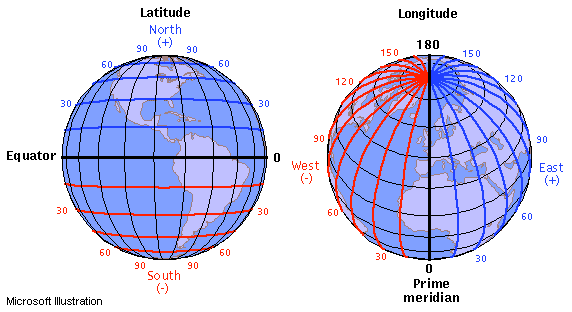latitude and longitude
LATITUDE AND LONGITUDE are points on lines that graph the Earth and allow cartographers and others, by assigning measurements to the lines, to fix the location of any place. Latitude lines run east and west and are also called parallels; longitude lines run north and south and are known as meridians. The measurements for both are given in degrees; more exact locations are expressed by increments of minutes and seconds.
Lines indicating latitude circle the globe in an eastwest direction, between the North and South Poles. Latitude lines parallel the equator, itself an imaginary line but one that can be determined with exactness. The equator lies midway between the North and South Poles and is assigned a latitude of 0 degrees. All other points are given in relation to their distance north or south of the equator. The highest latitude possible is 90 degrees, which is the latitude of the North and South Poles: 90 degrees N and 90 degrees S. Each degree of latitude extends 69 mi (111 km).

Ptolemy was the first to use latitude and longitude lines and measure them in degrees in his book, Geography, written around 150 B.C.E. Today, well-known lines of latitude enclose the ANTARCTIC and ARCTIC CIRCLEs at 66 degrees 33 minutes south or north, which defines the area that experiences at least one full day of darkness in winter. Other named latitude lines are the Tropics of Capricorn and Cancer, which are at 23 degrees 27 minutes south or north. The TROPIC OF CAPRICORN and the TROPIC OF CANCER mark the points furthest south and north, where the sun can be seen directly overhead at least one day during the year.
Longitude lines, which had been envisioned on maps from Ptolemy's time, were far more difficult to fix with accuracy. While the north-south lines can be drawn anywhere on a globe, the questions of where to place 0 degrees and how to measure from it were not resolved until recently. Unlike latitudes, which parallel each other, longitudinal lines are further apart from each other at the equator, and converge at the poles.
Since the measurement of any such line could follow the sun, going from east to west, it can be a measurement of time as well as distance. The Earth is 360 degrees, divisible by 24-hour periods; the Earth rotates 15 degrees each hour. For ships at sea, figuring longitude—and thus, their own location—meant knowing the exact time in their home port, as well as the exact time at sea, and measuring the difference. In 1714, the British Longitude Act offered a prize of 20,000 pounds to anyone who could track longitude with an accuracy of .5 degrees.
In the 1770s, the prize was won by a clockmaker named John Harrison, whose chronometers were proved accurate on voyages with Captain James Cook. In 1884, the British government declared that the meridian running through the Greenwich Observatory near LONDON, England, would be the prime meridian, with a measurement of 0 degrees. Previous to that, and previous to acceptance of that decree by other countries, other meridians had served as 0 degrees. Washington D.C. and PARIS, FRANCE, for example, measured longitude from their own Prime Meridians.
Traveling west from the Greenwich Observatory, any spot between 0 degrees and 180 degrees, is considered west longitude. The line at 180 degrees is exactly opposite the Prime Meridian on the other side of the Earth, and serves as the INTERNATIONAL DATE LINE. Going east, any location between 0 degrees and 180 degrees is designated east longitude.
Fixing latitude and longitude in the 21st century relies more on satellite technology than chronometers. The Global Positioning System (GPS) was developed and deployed by the U.S. Department of Defense to find coordinates on or above the Earth. Electronic receivers decode and triangulate the information from this system to give latitude, longitude, and elevation. GPS receivers have varied uses: scientists and engineers measure tectonic movement, industries track their vehicles, and ordinary consumers navigate while sailing or hiking. Civilian use is deliberately degraded and limited to 100 meters, while military use of Precision (P) code is accurate to 20 meters.
GPS is called NAVSTAR (an acronym for Navigation System with Timing and Ranging) by the U.S. military, and became fully operational in 1994. Between 1989 and 2004, 50 GPS satellites had been deployed. A minimum of 24 circle the globe on six orbital planes.
Longitude and latitude coordinates may be collected by a GPS receiver and uploaded into a geographic information system (GIS). Data capture (the insertion of information into the system) requires identifying the objects on a map and noting their precise global positions and their spatial relationships. Information from satellite images or aerial photographs may also be extracted with computer software and placed into the database. Existing digital information that is not in map form can be converted by GIS into usable form.